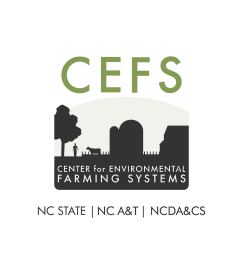By Emily Edmonds, Project Extension & Outreach Program Manager, NC Growing Together
Local governments – especially planners, economic developers, and small business centers – are increasingly interested in how to nurture and expand agriculture and food access in their communities. Connecting them to the wealth of knowledge available from the CEFS partnership of NC State, NC A&T State University, and the N.C. Department of Agriculture brings together powerful tools for making a real impact on the lives of North Carolinians.
At CEFS’ NC Growing Together (NCGT) initiative, we’ve been working hard for the past few months on an exciting new project: Local Food Economies (LFE). LFE brings the world-class research and Extension activities of CEFS within reach of a whole new audience who can use those tools in a whole new way.
Our state’s 100 counties and 552 municipalities are diverse: urban, suburban, and rural, spread across different geographies and climates. Farm and food business opportunities are just as diverse, responding to a steadily increasing demand for North Carolina products that spans industries from brewing and distilling to restaurants to institutional foodservice.
NCGT efforts focus on three key areas where food system expansion can have a real impact: planning, economic development, and business development & entrepreneurship. Each component of the LFE provides practical tools for this work as well as examples from across North Carolina of successful projects and programs.
Local Food Economies Satisfy the Many Demands of Land Use Planning
Local governments face critical issues in planning today, with a growing population, new migration patterns, and economic drivers changing the way people live, play, work, and travel. Planning with food access and agriculture in mind can help ease development pressures by incentivizing the protection of farmland; creating smart avenues for growth while preserving local character; and ensuring that citizens have access to the infrastructure and land needed to grow and consume locally produced foods.
Some of the unique approaches we’ve seen include special zoning districts to support urban agriculture; agricultural enterprise support zones; county-supported infrastructure, such as cold storage or processing; land use patterns that protect farmland and incentivize protection through tax programs; and counties that utilize tax structures to create funding for agribusiness use. Whatever the strategy, it’s clear that more local governments are responding to the desire for increased local food production and new markets for those products.
Local Food Economies Create Resiliency in Difficult Economic Times
Because they span such diverse industries, local food economies are interconnected to businesses across the economy. It’s no longer just restaurants and wholesalers purchasing farm products. Breweries and distilleries want local hops, grains, fruits, and starches, and local timber for oak casks for storage. Small trucking companies are in high demand to provide cold storage and cold-chain distribution across regional markets. Downtown revitalization occurs around anchor tenants like farm-to-fork restaurants, breweries, and specialty markets. Supporting agriculture and food businesses provides support to an entire network of entrepreneurs and small businesses, creating and retaining new businesses.
Similarly, local food economies contribute to the overall economic attractiveness of a community for a wide range of companies. An IT company’s site selection process, for example, often takes into account the local culture, seeking out counties or towns that have a thriving business district with unique local offerings and a strong sense of community. Their employees place a high priority on community resources. Communities with strong local food economies can meet all of those needs – and smart governments use them as a showcase for recruitment and expansion.
Local Food Economies Support Entrepreneurs in a Market That’s Not Slowing Down
Perhaps the most visible immediate impact of local food economies is the market opportunity they provide to entrepreneurs. Every small farm is essentially an entrepreneurial adventure, and food companies that process those products are also increasingly in demand. In the U.S., farmers’ markets have expanded by nearly 400% since 1994 – and now technology and food are creating opportunities we couldn’t have dreamed of then, like home delivery services, app ordering, and online wholesale purchasing. Small businesses have a unique opportunity in today’s market for local products to find a niche and meet a growing demand.
LFE on the Road
We know there are more great examples of how local governments and local food can transform regional economies. We’re excited to be joining some of our state’s leading governmental associations over the next several months to bring these resources to communities across the state – and to learn more about how we can continue to support this connection. Look for us at the events below – we’d love to talk more with you!
August 17: USEDA Food Systems Training for NC Councils of Government (closed registration)
September 14-16: NCAPA Annual Conference
September 26-27: NC Rural Assembly
October 11: ELGL Food Systems for Local Governments Webinar
October 21: ELGL Pop-Up Conference in RDU
November 15: SBTDC/SBC Annual Conference
For more information about the Local Food Economies initiative, or any of the above events, please contact Emily Edmonds.


